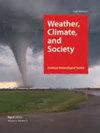How Visual Design of Severe Weather Outlooks Can Affect Communication and Decision-Making
IF 1.9
4区 地球科学
Q3 ENVIRONMENTAL STUDIES
引用次数: 0
Abstract
Abstract Multiday severe weather outlooks can inform planning beyond the hour-to-day windows of warnings and watches. Outlooks can be complex to visualize, as they represent large-scale weather phenomena overlapping across several days at varying levels of uncertainty. Here, we present the results of a survey ( n = 417) that explores how visual variables affect comprehension, inferences, and intended decision-making in a hypothetical scenario with the New Zealand MetService Severe Weather Outlook. We propose that visualization of the time window, forecast area, icons, and uncertainty can influence perceptions and decision-making based on four key findings. First, composite-style outlooks that depict multiple days of weather on one map can lead to biased perceptions of the forecast. When responding to questions about a day for which participants accurately reported there was no severe weather forecast, those who viewed a composite outlook reported higher likelihoods of severe weather occurring, higher levels of concern about travel, and higher likelihoods of changing plans compared to those who viewed outlooks that showed weather for each day on a separate map, suggesting that they perceived the forecast to underrepresent the likelihood of severe weather on that day. Second, presenting uncertainty in an extrinsic way (e.g., “low”) can lead to more accurate estimates of likelihood than intrinsic formats (e.g., hue variation). Third, shaded forecast areas may lead to higher levels of confidence in the forecast than outlined forecast areas. Fourth, inclusion of weather icons can improve comprehension in some conditions. The results demonstrate how visualization can affect decision-making about severe weather and support several evidence-based considerations for effective design of long-term forecasts. Significance Statement Severe weather outlook forecasts can be hard to clearly communicate because they show multiple weather patterns across multiple days and regions with varying uncertainty. The purpose of this study is to explore how visual elements of outlook design affect the way that people understand this complex content. We had three separate groups respond to the same series of questions while viewing different modified versions of the MetService Severe Weather Outlook in Aotearoa New Zealand and compared their responses. We find that the way the outlooks’ time window, forecast area, icons, and uncertainty are visualized can influence how people understand outlooks and make inferences and decisions about severe weather. We discuss how these influences may impact communication and action and present several evidence-based considerations for effective outlook design.恶劣天气前景的视觉设计如何影响沟通和决策
多天的恶劣天气前景可以在每天一小时的预警和观察窗口之外为规划提供信息。天气前景的可视化可能很复杂,因为它们代表了在不同程度的不确定性下重叠在几天内的大规模天气现象。在这里,我们展示了一项调查的结果(n = 417),该调查探讨了视觉变量如何影响新西兰气象局恶劣天气展望的假设场景中的理解、推断和预期决策。我们提出可视化的时间窗口,预测区域,图标和不确定性可以影响感知和决策基于四个关键发现。首先,在一张地图上描绘多天天气的综合展望可能导致对预报的偏见。在回答有关参与者准确报告没有恶劣天气预报的那一天的问题时,与那些在单独的地图上显示每天天气的人相比,那些观看综合展望的人报告了更大的恶劣天气发生的可能性,对旅行的担忧程度更高,改变计划的可能性也更高,这表明他们认为天气预报低估了当天恶劣天气的可能性。其次,以外在方式(例如,“低”)呈现不确定性可以比内在格式(例如,色调变化)更准确地估计可能性。第三,阴影预测区域可能比轮廓预测区域对预测的信心更高。第四,在某些情况下,包含天气图标可以提高理解能力。结果证明了可视化如何影响恶劣天气的决策,并为有效设计长期预报提供了一些基于证据的考虑。恶劣天气预报很难清晰地传达,因为它们显示了多个天和不同地区的多种天气模式,具有不同的不确定性。本研究的目的是探讨外观设计的视觉元素如何影响人们理解这一复杂内容的方式。我们让三个独立的小组在观看新西兰奥特阿瓦的MetService恶劣天气展望的不同修改版本时回答相同的一系列问题,并比较他们的回答。我们发现,天气前景的时间窗口、预报区域、图标和不确定性的可视化方式会影响人们对天气前景的理解,并对恶劣天气做出推断和决定。我们将讨论这些影响如何影响沟通和行动,并为有效的前景设计提出几个基于证据的考虑因素。
本文章由计算机程序翻译,如有差异,请以英文原文为准。
求助全文
约1分钟内获得全文
求助全文
来源期刊

Weather Climate and Society
METEOROLOGY & ATMOSPHERIC SCIENCES-
CiteScore
3.40
自引率
13.60%
发文量
95
审稿时长
>12 weeks
期刊介绍:
Weather, Climate, and Society (WCAS) publishes research that encompasses economics, policy analysis, political science, history, and institutional, social, and behavioral scholarship relating to weather and climate, including climate change. Contributions must include original social science research, evidence-based analysis, and relevance to the interactions of weather and climate with society.
 求助内容:
求助内容: 应助结果提醒方式:
应助结果提醒方式:


